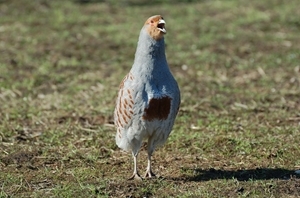Grey partridge
 If you have ever stood in classic, expansive “open” partridge country as the light fades across the vast sky, surrounded by the ratcheting calls of greys as they prepare to jug, then you must know that this bird, perhaps more than any other, represents our mixed and arable British farmland.
If you have ever stood in classic, expansive “open” partridge country as the light fades across the vast sky, surrounded by the ratcheting calls of greys as they prepare to jug, then you must know that this bird, perhaps more than any other, represents our mixed and arable British farmland.
Wild grey partridge often fly out into the middle of a field in the evenings so that they leave no scent behind to attract a passing fox, gathering together in a group (known as a covey) to jug (roost). They will stay in these family coveys all winter, until the days start to lengthen and the signs of spring begin to show, whereupon the males will disperse to find a mate. They will never choose a hen from within their own family covey.
The grey partridge lays the largest clutch of eggs of any bird species. In Britain, 14-15 eggs are typical but I once saw an adult pair with 21 chicks in Norfolk. These amazing birds not only raise big families but must surely also be in the number one spot for their parenting skills too. In any pair, he is every bit as important to the survival of the chicks as she is – a very modern marriage!
Should you ever happen across a pair of greys with newly-hatched little bumble bee-sized chicks, you could be rewarded with a wonderful spectacle. As often as not, the cock bird will drop a wing to the ground, flapping and scuffling along the ground, immediately catching your eye. Once you have followed this “injured” bird for a short distance, up he will fly with a burst of power that only perfect wings can supply! The chicks meanwhile are nowhere to be seen, led quietly away to safety by the hen. This is team work at its best, brilliantly designed to deflect the attention of potential predators!
For the person interested in shooting or falconry this is a game bird perhaps only equalled by the grouse, because they “burst and spread” like the contents of a firework as they come whirring over the hedge, making them a very superior quarry. They are also a brilliant “barometer” of the general health of farmland. So, to have a “harvestable surplus” to enable shooting requires all the appropriate habitats to be in place, meaning that managing ground for the grey partridge’s welfare also delivers huge benefits to the other species that inhabit the same land.
Unfortunately however, the current estimated population is only around 43,000 pairs, which is substantially less than the million pairs that existed back in the first half of the 1900s. So what has caused this decline?
Research carried out by the GWCT showed that chick survival rates fell from an average of 45% to under 30% between 1952 and 1962 and has continued to stay low ever since. In the first weeks of life, the chicks feed almost exclusively on insects to obtain the proteins needed for rapid growth. The introduction of herbicides in the early 1950s eliminated many crop weeds that were insect food plants and by the 1980s the number of chick food insects in cereals had fallen by at least 75%.
Ironically, some would say, shooting estates that concentrate on looking after the wild grey partridge are without doubt proving to be the saviour of this iconic species. For example, one estate in Sussex has worked very hard to put all the required habitats back in place once more, which when coupled with targeted, legal control of foxes and crows, has seen grey partridge breeding density increase from 0.3 pairs per 100ha in 2003 to nearly 20 pairs per 100ha in 2010.
This is now being replicated across the country by people, often with a shooting interest, who are motivated enough to manage the land and then count their grey partridge, sending in the figures to the GWCT. If you just look at these inspired land managers, figures show that there has been an 81% increase in partridge pairs on count farms from 2000 to 2010, whereas national data still points to a decline of 30% over exactly the same period.
Learn more about the GWCT’s Partridge Count Scheme here.
Peter Thompson
Advisory
Read more from Peter Thompson at the Fresh from the Field blog.

Download Peter Thompson's essential 26-page book, featuring beautiful photography and detailed profiles of Britain's wildlife
Download FREE >